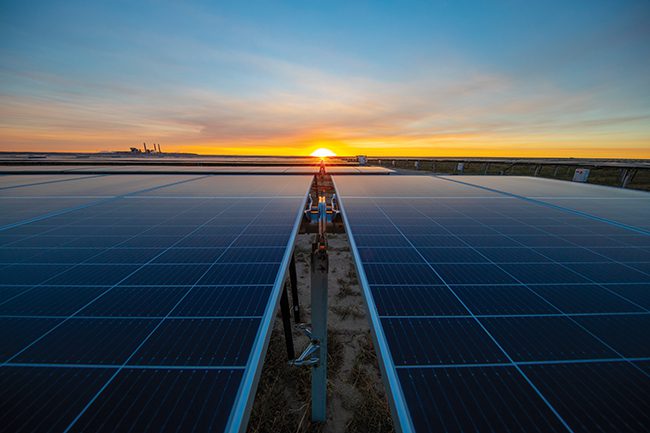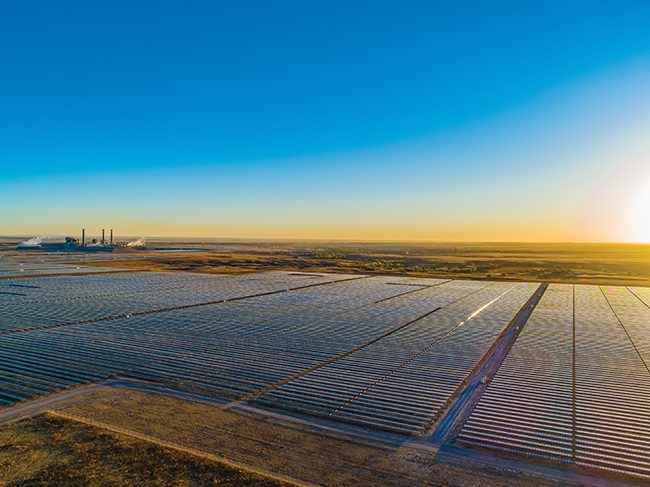

The Bighorn Solar farm has been called the future of renewable energy. It’s a project dedicated to providing cleaner power for a major industrial facility, while also investing in the community and preserving local jobs.
When the United Nations and other organizations began discussing how to make industrial processes more sustainable and environmentally friendly, the groups knew it would take buy-in from utilities, businesses, and communities to bring projects to life. Today, the “Greening of Industry” is moving forward, with a shift toward sustainable business practices more prevalent than ever. The transition to a low-carbon economy is being embraced in many sectors, even those traditionally reliant on fossil fuels.
The Bighorn Solar project in Colorado is an example. Bighorn Solar is a 300-MW photovoltaic solar farm, developed by Lightsource bp to power the EVRAZ Rocky Mountain steel mill in Pueblo. Bighorn is at present the largest onsite solar power plant for a U.S. industrial facility, and also the first such facility in the country to be dedicated to a steel mill.
Xcel Energy, Colorado’s largest utility, delivers electricity from Bighorn to the mill, one of the city’s largest employers. The project operates under a 20-year, fixed-rate power purchase agreement (PPA), providing stable electricity prices that the mill needed to remain in Pueblo and continue to support more than 1,000 jobs in the local community.
Kevin Smith, CEO for Lightsource bp, Americas, said, “This project proves that even hard-to-abate sectors like steel can be decarbonized when companies come together with innovative solutions. Our collaboration with Xcel Energy and EVRAZ North America made Bighorn Solar a reality. It’s a great example of partners tackling complex issues that U.S. industry is facing today, while at the same time preserving jobs in the manufacturing sector.”
Core of a Community
The production of steel has been the backbone of Pueblo’s economy since the mill first began operating in the late 1800s. The mill over the past few decades has been powered by Xcel’s Comanche coal-fired power plant (Figure 1). When state officials mandated a move to carbon-free power, and Xcel said it would shut down Comanche’s units sooner than expected, the mill’s operators had a choice—find a new source of power, or move from Pueblo.
 |
|
1. The Comanche power plant is seen at the upper left of this photo, a backdrop to Bighorn Solar’s vast array of more than 750,000 solar panels. Courtesy: Lightsource bp |
Enter Bighorn Solar, operated by Lightsource bp, which financed and designed the project. The solar farm is located on about 1,800 acres between Comanche and the steel mill. Construction began in October 2020, with the installation completed a year later. Lightsource bp sells the electricity to Xcel Energy, which then provides power to EVRAZ North America, Xcel’s largest retail electric customer in Colorado. The mill recycles scrap metal into new, clean steel.
Skip Herald, CEO of EVRAZ North America, at the project’s dedication last year, said, “Like bp and Xcel Energy, EVRAZ is committed to reducing emissions and operating more sustainably. As each new acre of solar panels is installed, we find ourselves closer to our goal of making EVRAZ in Pueblo one of the greenest steel facilities in the world. The journey shows what can happen when like-minded companies come together and work across government and industry to promote cleaner energy, cleaner products and more resilient communities. This is an incredible milestone.”
Xcel has said the solar farm supports the utility’s Colorado Energy Plan target of delivering 55% renewable energy to the state’s power grid by 2026, along with helping achieve a 60% reduction in carbon emissions. Xcel also has said Bighorn is an important project to help the company provide 100% carbon-free electricity to customers by 2050.
Bob Frenzel, president and CEO of Xcel Energy, at the project’s dedication, said, “This is an exciting day for us at Xcel Energy. Working together with Lightsource bp and EVRAZ North America, we’re creating innovative solutions for our customers while developing new solar energy resources in Colorado. Through this collaboration we’re bringing jobs to the community, harnessing our natural resources and increasing renewable energy in the state.”
Bighorn Solar created about 300 direct jobs during its construction phase and is expected to generate more than $ 22 million in local tax revenue during its operation.
750,000 Solar Panels
Bighorn Solar includes more than 750,000 solar panels, bifacial solar PV modules on single-axis trackers. Lightsource bp said the solar farm is expected to produce 613,400 MWh of power annually, providing about 90% of the steel mill’s annual electricity demand.
Lightsource bp and other investors in the project closed a $ 285 million financing package for Bighorn Solar in October 2020. The company secured tax equity financing from Bank of America, while debt for the facility was provided by Sumitomo Mitsui Banking Corp. (SMBC), Societe Generale, and Export Development Canada (EDC).
Lightsource bp awarded a contract to McCarthy Building Companies to provide engineering, procurement, and construction (EPC) services for the project. Canadian Solar, a PV panel manufacturer based in Ontario, Canada, supplied the solar modules. The single-axis trackers supporting the solar panels were supplied by NEXTracker. Operis conducted a review of the financial model for Lightsource bp for the solar project, and CohnReznick Capital advised Lightsource bp on the tax equity transaction.
Said Smith, “Bighorn Solar is an example of how we layer additional benefits onto our solar projects—beyond clean energy generation and the fact that Xcel Energy is delivering the electricity to power the world’s greenest steel. Wherever possible, Lightsource bp builds multiuse solar projects on which clean energy generation, habitat enhancement and conservation all share the land under and around the solar panels.”
Smith said Lightsource bp is committed to increasing net biodiversity on its project sites. Both Bighorn Solar, and the nearby 293-MW Sun Mountain solar farm—which also will operate under a PPA with Xcel—were designed to deliver renewable energy while also sharing the land with conserved shortgrass prairie, considered a habitat in peril. A total of 3,051 acres of shortgrass prairie will grow on and around the Bighorn and Sun Mountain sites, according to Smith.
Before construction began, Smith said Lightsource bp and its partners designed a site-specific seed mix, suited to the local climate, ecosystem, and soil. The mix contains staple short grasses like western wheatgrass, buffalo grass, and little bluestem, as well as a low concentration of purple prairie clover to provide nectar for pollinating insects.
Construction Challenges
Smith said Bighorn Solar “progressed on time and on budget despite global headwinds that impacted how we all worked and our supply chains. In April 2020, just a month after the World Health Organization declared COVID-19 a pandemic, our development team received our major permits for the Bighorn project, with the Pueblo Board of County Commissioners working remotely. Our construction team hired an EPC contractor for the project, selected and purchased major equipment such as modules, transformer, trackers, inverters.”
Smith told POWER, “Overall financing of the project included equity investment from Lightsource bp, but also required project debt and tax equity investments. The debt and tax equity markets had been affected by the COVID-19 crisis, but our project finance team was able to close on project financing in the fall of 2020. The project entered full commercial operation on schedule at the end of 2021.”
Lightsource bp has several projects where the generation from solar projects are tied to PPAs with utilities. In addition to Bighorn, Smith said they include the Sun Mountain project with Xcel in Pueblo; the Johnson Corner project in Kansas with Sunflower Electric Power Corp.; the Wildflower installation with Sacramento Municipal Utility District (SMUD) in California; the Grants & Bluewater project with Continental Divide Electric Cooperative (CDEC) in New Mexico; the Conway at Happy with Conway Corp. in Arkansas; and the Black Bear project in Alabama, with Alabama Municipal Electric Authority.
Said Smith: “Community engagement is a priority for Lightsource bp. As our projects’ owner/operator, we are long-term partners of the communities that are home to our solar projects—and we want to make positive contributions to those communities.”
The CEO cited examples of the community work done in conjunction with Bighorn, noting, “For the last two school years, Lightsource bp has partnered with Care and Share food bank to support the Minnequa Elementary School, which is located in Pueblo close to Bighorn. At Minnequa Elementary we’re also sponsoring a student activity fund, which provides students with after-school community excursions as experiential enrichment learning and as an incentive for academic achievement. Working with GRID Alternatives, we sponsored a solar training program for unemployed and underemployed workers in Pueblo.”
 |
Colorado Gov. Jared Polis as part of the project’s announcement in 2020 said, “This collaborative project will not only bring more jobs to Pueblo, but also supports Colorado’s goal of reaching 100% renewable energy by 2040.” Polis has touted the project as an example of the future of renewable energy, where industry is a driver of renewable energy installations.
“The EVRAZ steel mill is a staple of Pueblo’s incredible history and will now also serve as a pillar of our state’s clean energy future,” said Polis. “This is a great example of how solar can help revitalize our economy, as well as lead our transition to low-carbon energy that includes everyone.”
—Darrell Proctor is a senior associate editor for POWER (@POWERmagazine).
The post Solar Project Forges a Bright Future for Colorado Steel Mill appeared first on POWER Magazine.